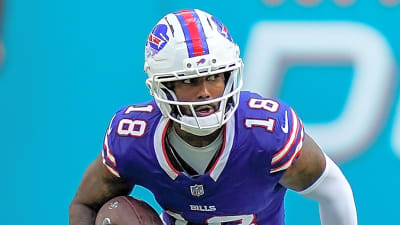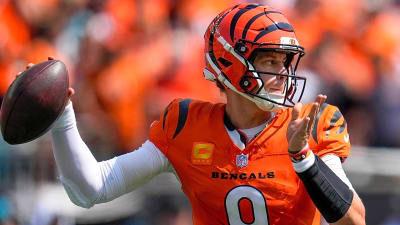
On Wednesday, we highlighted the diminishing production of New York Jets edge rusher Will McDonald compared to his impressive 2024 season.
McDonald currently ranks 40th among edge rushers with just 28 total pressures (2.5 per game), a far cry from his previous campaign, when he finished 13th at the position with 61 total pressures (3.6 per game), per Pro Football Focus.
So far in 2025, McDonald has recorded four-plus pressures in just one game (Week 10 vs. Cleveland). Last season, he did it nine times, including six performances through this point of the season.
Based on these numbers, it seems inarguable that McDonald is having a less impressive season than last year. Yet, the article generated divisive responses.
Some Jets fans agreed that McDonald has not been delivering what the Jets need from him; these fans also commonly rued the Jets’ decision to select him over Ohio State wide receiver Jaxon Smith-Njigba. Other Jets fans, though, defended the third-year pass rusher.
Among fans who defended McDonald’s significant decline in production, one of the most common arguments was that he doesn’t get a fair chance to produce because he plays on a team that rarely holds the lead.
It’s a reasonable hypothesis, but does it hold up when tested?
Is Will McDonald hindered by the Jets’ inability to hold a lead?
I prefer Pro Football Focus’s tracking of pressure numbers (they seem to be the most accurate when comparing their pressure totals to what I see on film), but they don’t offer the ability to filter those numbers through various splits. Using NFL Pro’s data, we can break down McDonald’s pass-rush production by scoreboard or down-and-distance.
When it comes to tracking pressures, the difference between NFL Pro and PFF is that NFL Pro utilizes GPS tracking data, whereas PFF’s stats are charted manually by humans. Both systems have pros and cons, but I ultimately prefer PFF’s method. Nonetheless, NFL Pro will suffice for this exercise, as its filters are perfect for the questions we are trying to unpack here.
McDonald’s defenders do have a point in that he has enjoyed fewer opportunities to rush with a lead this season. In 2024, he played 204 pass-rush snaps with a lead, an average of 12.0 per game across 17 appearances. In 11 games this year, McDonald has played just 85 pass-rush snaps with a lead, way down to 7.7 per game.
Interestingly, McDonald’s efficiency when rushing with a lead has not changed at all. He had a 17.6% pressure rate in these situations last season, and in 2025, that number is exactly the same. It’s an elite number; last year, it ranked third-best among qualified players.
In this way, it is absolutely true that McDonald has been hindered by the Jets spending more time trailing. Last season, the Jets led on 49.2% of McDonald’s pass-rush snaps, and this year, that rate has free-fallen to 33.4%. Since he has been equally efficient with a lead across both seasons, the sharp decline in opportunities to rush with a lead can certainly explain part of his overall production dip.
It is not the main reason, though.
Here’s where the defense of McDonald falls apart: He was still dominant in 2024 when rushing without a lead. This year, he has been almost invisible in those very same situations.
In 2024, McDonald had a 15.1% pressure rate when the Jets were tied or trailing. That’s only 2.5% lower than his pressure rate while leading. This season, though, McDonald has a paltry 7.7% pressure rate when the Jets were tied or trailing, almost 10% lower than his pressure rate while leading.
Let’s round up the numbers:
- 2025: Pass-rush snap split: 33.4% leading, 66.6% tied or trailing / Pressure rate: 17.6% leading, 7.7% tied or trailing
- 2024: Pass-rush snap split: 49.2% leading, 50.8% tied or trailing / Pressure rate: 17.6% leading, 15.1% tied or trailing
So, yes, part of McDonald’s decline can be explained by a decrease in chances to rush with a lead, as he, like most pass rushers, is more productive when holding a lead.
However, for the argument to hold firm, McDonald would have to be performing equally well without a lead as he did last year. In that case, his decline could be fully explained by the changes to his opportunities rather than a dip in his own efficiency.
That’s not what we’re seeing here. McDonald’s overall decline has primarily occurred because he is performing substantially worse when the Jets aren’t leading, and that cannot be written off. As a starter and former first-round pick, he should be expected to produce at a high level no matter what the score is; after all, he did it last year.
In his dominant 2024 season, McDonald still picked up 32 pressures when tied or trailing, tied for the 14th-most among all players. This season, he has only 13 pressures when tied or trailing, tied for 44th. That’s a 30-spot drop, despite McDonald getting more opportunities to rush in these situations (15.4 per game this year vs. 12.7 per game last year).
Further weakening the popular defense of McDonald is his silence on third-and-long. This is a situation where, regardless of the score, the opposing team is highly likely to pass, making it a favorable situation for the edge rushers. It’s the type of scenario where McDonald should feast, whether he’s on a good team or not.
McDonald was monstrous on third-and-long last year. This season, he has been shut down in those situations.
Last year, McDonald had 20 pressures on third & 7+, tied with Myles Garrett and Travon Walker for sixth-most among all players. His pressure rate in these situations was an outstanding 23.3%.
This season, McDonald has just six pressures on third & 7+, tying him for 50th in the league. His pressure rate is a ghastly 9.2%, ranking third-worst among edge rushers with at least 50 opportunities in that situation (ahead of D.J. Wonnum and Dre’Mont Jones).
Here’s where the case is closed: McDonald has actually enjoyed more third-and-long opportunities this year. In 2024, he had 85 pass-rush snaps on third & 7+, an average of 5.0 per game. This year, he’s already had 65 of those snaps in 11 games, an increase to 5.9 per game.
So, yes, McDonald has spent less time playing with a lead this year, but he’s actually enjoyed slightly more third-and-long chances, and yet, he has been substantially less efficient in those scenarios.
Simply put, McDonald has taken a step back this year. There are many potential explanations for it, whether he has lost some explosion due to his offseason weight gain, isn’t an ideal fit for the Jets’ new scheme, is drawing more attention from opposing offenses (unlikely, since he has Jermaine Johnson now and didn’t last year), or simply isn’t executing up to his capabilities.
The reasons for McDonald’s dip are open for debate. What cannot be debated, though, is that McDonald is capable of much better than what he’s put on the field this year. He was far more impressive in 2024, and there is no excuse that can be used to deny that.
Over the next six games, McDonald needs to prove that he can return to the level of dominance that he showed in 2024. Otherwise, there might not be a future for him in Florham Park. The type of production McDonald has generated this year is not what the Jets are looking for from a starting edge rusher.
As a lanky defensive end with limited skills against the run, McDonald needs to yield elite pass-rush production in all situations to justify a starting role, and he hasn’t done that this year. If he can only be productive when the grass is greenest, perhaps he should be limited to a situational pass-rushing role next year.
Maybe, though, considering how much he’s dipped on third-and-long this year (despite maintaining his efficiency with a lead), he simply isn’t a fit in the Jets’ read-and-react scheme, and would be better off returning to an attack-based scheme like Robert Saleh’s.
Some Jets fans may be willing to write off McDonald’s struggles and continue viewing him as the cornerstone he seemed to be after the 2024 season, but as the data shows, it is nowhere near that simple. The Jets will have a complicated situation to unpack with McDonald if he does not turn up the heat over the next six games.
More must-reads:
- Bills cut wide receiver amid Keon Coleman drama
- Every NFL Thanksgiving game has massive playoff implications
- The 'Three-TD, Three-INT NFL games' quiz
Breaking News
Trending News
Customize Your Newsletter
 +
+
Get the latest news and rumors, customized to your favorite sports and teams. Emailed daily. Always free!








